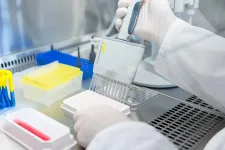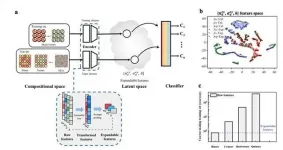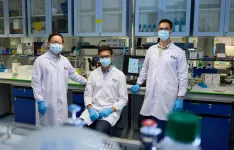(Press-News.org) Cutting-edge 3D scanners have been put to the test by researchers from the University of Southampton and partners Exceed Worldwide to help increase the quality and quantity of prosthetics services around the world.
The study, carried out within the END
Cambodian study assesses 3D scanning technologies for prosthetic limb design
2021-03-17
ELSE PRESS RELEASES FROM THIS DATE:
What brings olfactory receptors to the cell surface
2021-03-17
A team of scientists led by Dietmar Krautwurst from the Leibniz Institute for Food Systems Biology at the Technical University of Munich has now identified address codes in odorant receptor proteins for the first time. Similar to zip codes, the codes ensure that the sensor proteins are targeted from inside the cell to the cell surface, where they begin their work as odorant detectors. The new findings could contribute to the development of novel test systems with which the odorant profiles of foods can be analyzed in a high-throughput process and thus could be better controlled.
The ...
Crystal structure prediction of multi-elements random alloy
2021-03-17
Alchemy, which attempted to turn cheap metals such as lead and copper into gold, has not yet succeeded. However, with the development of alloys in which two or three auxiliary elements are mixed with the best elements of the times, modern alchemy can produce high-tech metal materials with high strength, such as high entropy alloys. Now, together with artificial intelligence, the era of predicting the crystal structure of high-tech materials has arrived without requiring repetitive experiments.
A joint research team of Professor Ji Hoon Shim and Dr. Taewon Jin (first author, currently at KAIST) of POSTECH's Department of Chemistry, and Professor Jaesik Park of POSTECH Graduate School of Artificial Intelligence have together developed a system that predicts ...
Not just for numbers: Anchoring biases decisions involving sight, sound, and touch
2021-03-17
TROY, N.Y. -- Numeric anchoring is a long-established technique of marketing communication. Once a price is mentioned, that number serves as the basis for -- or "anchors" -- all future discussions and decisions. But new research shows that this phenomenon is not limited to decisions that involve numbers, the use and understanding of which require high-level cognitive thinking. Anchoring also biases judgments at relatively low levels of cognition when no numbers are involved.
In research recently published in the Journal of Behavioral Decision Making, Gaurav Jain, an assistant professor in the Lally School of Management at Rensselaer Polytechnic Institute, demonstrated that anchoring even occurs in perceptual domains, ...
FAU researchers break bonds in molecular nitrogen with calcium
2021-03-17
Chemists all over the world are constantly searching for simple ways to make elemental nitrogen or N2 in the air available for chemical reactions. This is no easy task, as nitrogen is a particularly non-reactive gas with a triple bond, which is one of the strongest known chemical bonds. A research team at Friedrich-Alexander-Universität Erlangen-Nürnberg (FAU) has now demonstrated that calcium, a metal commonly found in nature, is able to break the highly-stable nitrogen bond and can do so at minus 60°C. This is significant for two reasons. On the one hand, the researchers at FAU have made a new discovery in terms of the bond-breaking capabilities of calcium, which had been largely disregarded in the past. On ...
It's snowing plastic
2021-03-17
The snow may be melting, but it is leaving pollution behind in the form of micro- and nano-plastics according to a McGill study that was recently published in Environmental Pollution. The pollution is largely due to the relatively soluble plastics found in antifreeze products (polyethylene glycols) that can become airborne and picked up by the snow.
The researchers used a new technique that they have developed to analyze snow samples collected in April 2019 in Montreal for both micro- and nano-sized particles of various plastics. The McGill technique is orders of magnitude more sensitive than any of the other current methods used for tracing plastic in the environment. It ...
Certain mouthwashes might stop COVID-19 virus transmission
2021-03-17
Researchers at Rutgers School of Dental Medicine have found evidence that two types of mouthwash disrupt the COVID-19 virus under laboratory conditions, preventing it from replicating in a human cell.
The study, published in the journal Pathogens, found that Listerine and the prescription mouthwash Chlorhexidine disrupted the virus within seconds after being diluted to concentrations that would mimic actual use. Further studies are needed to test real-life efficacy in humans.
The study was conducted in a lab using concentrations of the mouthwash ...
Advisory: Study confirms vitamin D, fish oil don't lower atrial fibrillation risk
2021-03-17
A study published March 16 in JAMA (the Journal of the American Medical Association) confirms that neither vitamin D nor the omega-3 fatty acids found in fish oil prevent the development of atrial fibrillation (AF), a potentially serious heart rhythm disturbance. The newly published research follows a presentation made by Christine Albert, MD, MPH, at the American Heart Association Scientific Sessions last year.
In their JAMA analysis, Albert and her research team also examined whether vitamin D or omega-3 fatty acids might have an impact on paroxysmal versus persistent atrial ...
Semiconductor nanogrooves enhanced broad spectral band mmW and THz detection
2021-03-17
Millimetre and terahertz wave detectors have a wide range of applications in areas such as communications, security, biological diagnosis, spectroscopy, and remote sensing. They are the components that can transform light information loaded by long-wavelength millimetre and terahertz waves into electrical signals. High-performance room-temperature detectors with high sensitivity, fast response, broad spectral bandwidth, and possibility to be extended to large format arrays are always pursued. They are the building blocks for a wide range of millimetre ...
NUS researchers harness AI to identify cancer cells by their acidity
2021-03-17
Singapore, 17 March 2021 - Healthy and cancer cells can look similar under a microscope. One way of differentiating them is by examining the level of acidity, or pH level, inside the cells.
Tapping on this distinguishing characteristic, a research team from the National University of Singapore (NUS) has developed a technique that uses artificial intelligence (AI) to determine whether a single cell is healthy or cancerous by analysing its pH. Each cancer test can be completed in under 35 minutes, and single cells can be classified with an accuracy rate of more than 95 per cent.
The research, led by Professor Lim Chwee Teck, Director of the Institute for Health Innovation ...
The blast that shook the ionosphere
2021-03-17
A 2020 explosion in Lebanon's port city of Beirut led to a southward-bound, high-velocity atmospheric wave that rivaled ones generated by volcanic eruptions.
Just after 6 p.m. local time (15.00 UTC) on August 4, 2020, more than 2,750 tons worth of unsafely stored ammonium nitrate exploded in Lebanon's port city of Beirut, killing around 200 people, making more than 300,000 temporarily homeless, and leaving a 140-metre-diameter crater in its wake. The blast is considered one of the most powerful non-nuclear, man-made explosions in human history.
Now, calculations by Hokkaido University scientists in Japan have found that the atmospheric ...





